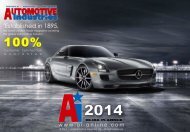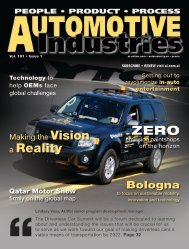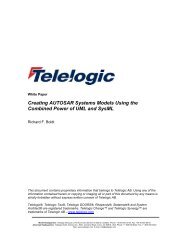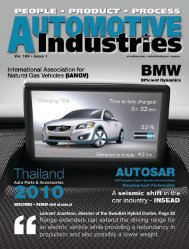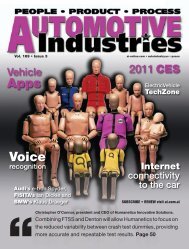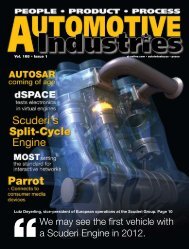engineering, AUTOSAR - Automotive Industries
engineering, AUTOSAR - Automotive Industries
engineering, AUTOSAR - Automotive Industries
Create successful ePaper yourself
Turn your PDF publications into a flip-book with our unique Google optimized e-Paper software.
innovation<br />
<strong>AUTOSAR</strong> release 4.0<br />
speeds up design By: Lenny Case<br />
Members of the AUTomotive Open System Architecture<br />
(<strong>AUTOSAR</strong>) Development Partnership presented their<br />
methods and solutions for an open, standardized software<br />
architecture at a joint booth at the electronica 2010 held<br />
from November 9 to 12 in Munich, Germany. At the centre of<br />
the <strong>AUTOSAR</strong> presentation was the Release 4.0, launched<br />
in December 2009, - which marked the end of phase two.<br />
Release 4.0 contains a large number of technical and functional<br />
improvements to functional safety, architecture, communication<br />
stack, methodology and templates, and application interfaces.<br />
A major focus of the development partnership was on<br />
maturing methodology and templates. Some of the<br />
upgrades in Release 4.0 included the harmonization<br />
Stefan Bunzel,<br />
spokesperson for<br />
<strong>AUTOSAR</strong><br />
of ECU configuration parameters, the enhancements<br />
on measurements and calibration, the rework of the<br />
ECU Resource Template as well as the further alignment<br />
with the Field Bus Exchange Format or FIBEX standard.<br />
According to Stefan Bunzel, spokesperson for the <strong>AUTOSAR</strong><br />
Partnership, <strong>AUTOSAR</strong>’s Release 4.0 facilitates the faster design<br />
and development of vehicle electronics. As the basic architecture<br />
of Release 4.0 is a logical development of the well-established<br />
architecture of Release 3.x, <strong>AUTOSAR</strong>-based applications will easily<br />
migrate to the new release while benefiting from new concepts like<br />
memory partitioning, or enhancements on the communication<br />
stack, like support for the FlexRay ISO Transport Protocol.<br />
<strong>AUTOSAR</strong> has selected about 50 technical concepts which will<br />
be developed and incorporated in the Release 4.1 until the end of<br />
2012. This selective enhancement aims at achieving backwards<br />
compatibility with former releases.<br />
The <strong>AUTOSAR</strong> partnership was founded in 2003/2004 by the<br />
BMW Group, Bosch, Continental, DaimlerChrysler, Ford, GM,<br />
PSA, Siemens VDO, Toyota and Volkswagen to develop an open,<br />
standardized software architecture for the automotive industry.<br />
The growing importance of <strong>AUTOSAR</strong> is proven by its growing<br />
global prominence. “More and more companies worldwide recognize<br />
that <strong>AUTOSAR</strong> is the key technology regarding infrastructure software<br />
for automotive systems. The results and the success of the second<br />
Open Conference in Tokyo in May 2010 proved that <strong>AUTOSAR</strong><br />
has been gaining momentum in Asia, particularly in Japan.<br />
The event fully underlined its motto of <strong>AUTOSAR</strong> as a<br />
global standard,” says Bunzel.<br />
This global prominence was confirmed<br />
in October 2010, when Indian firm KPIT<br />
Cummins Infosystems announced the<br />
availability of a software package based on the<br />
Herstellerinitiative Software recommendation<br />
for Scalable <strong>AUTOSAR</strong> Stack supporting 16<br />
bit <strong>AUTOSAR</strong> R3.1 Solution.<br />
There has been significant growth in the need for<br />
standardization of automotive software because of an<br />
increase of ECUs in cars. However, programs became too<br />
large for the standardized hardware components, and OEMs<br />
requested a solution with a smaller memory requirement, like the 16bit<br />
microcontroller. <strong>AUTOSAR</strong> meets these requirements by optimizing the<br />
code size according to recommended guidelines by HIS.<br />
<strong>Automotive</strong> <strong>Industries</strong> (AI) caught up with Stefan Bunzel,<br />
spokesperson of the <strong>AUTOSAR</strong> Partnership, and asked<br />
how successful electronica 2010 was from an <strong>AUTOSAR</strong><br />
perspective.<br />
bunzel: electronica has established its position as an<br />
important meeting point for the global electronics industry. The<br />
high number of international visitors and exhibitors confirmed the<br />
leading character of this trade fair.<br />
12 to read full version of AI stories go to www.ai-online.com




